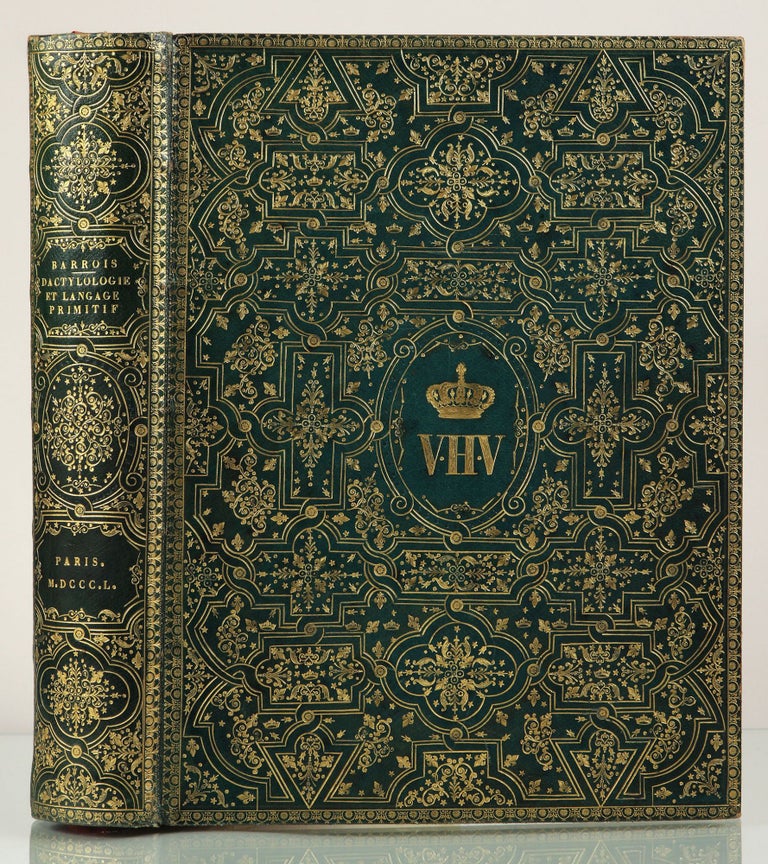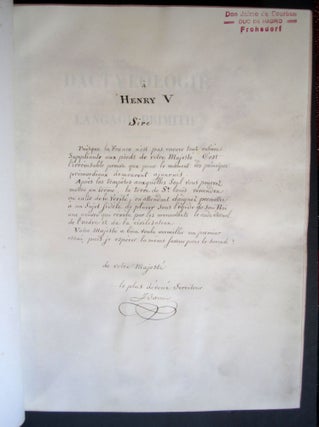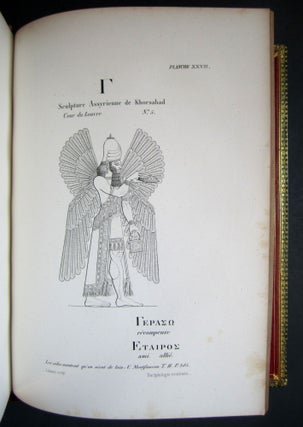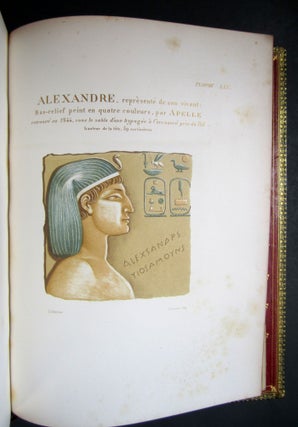Dactylologie et langage primitif restitués d’après les monuments. Paris: Firmin Didot frères [for the author], sold by Didot, Jules Renouard and Techener, 1850.
Large 4to (308 x 230 mm). [8], 360; 35 pp. Large-paper issue on heavy wove paper (papier vélin). Includes Greek printing. 61 plates of pen-and-ink lithographs with text, lithographed by Lalanne, printed by Lemercier, including one double-page plate and two chromolithographs with gold-printed captions. Occasional light foxing.
Presentation binding commissioned by the author for the royal pretender the Comte de Chambord as “Henri V”: elaborately gold-tooled contemporary green polished goatskin, covers tooled to a fanfare design incorporating fleurs-de-lys and royal crowns, central oval cartouche containing the crowned initial H flanked by two roman V’s, smooth spine similarly gold-tooled, red morocco doublures gold-tooled with a semis of crowned fleurs-de-lys, pair of vellum free endleaves and flyleaves at front and back, gilt edges (a few small scratches to lower cover, scuffing to hinges at head and foot); folding cloth case. Provenance: Henri-Charles-Ferdinand-Marie-Dieudonné d’Artois, duc de Bordeaux, Comte de Chambord (1820-1883), pretender to the throne of France, supra-libros, with an autograph letter of presentation from the author on a vellum leaf bound in between title and half-title; Don Jaime de Bourbon, duc de Madrid (1870-1931, Chambord’s legatee), red inkstamp on vellum dedication leaf; with Maggs Bros, catalogue 661 (1938), 172; Bernard Breslauer (Bibliotheca Bibliographica Breslaueriana, 33).
First Edition, “royal” presentation copy, of a treatise on the origins of language and on written symbols, the work of a wealthy collector, dealer in stolen manuscripts, and ardent Royalist.
Joseph Barrois was an erudite but eccentric and indeed crooked bibliophile who became fatally involved with the notorious and unpunished book thief Guglielmo Libri, who, in his capacity of inspector of public instruction, traveled throughout France surveying libraries and pillaging them. Barrois is known to have taken in “Libri’s” manuscripts and had them rendered unrecognizable through rearrangement of quires, rebinding, mutilation, etc. The unsigned binding was confidently attributed by Bernard Breslauer to the Parisian binder Thompson, who assisted Barrois in these fraudulent activities. Barrois also compiled his own valuable manuscript collection, about ten percent of which stemmed from compromised sources. Foreseeing Libri’s conviction, he had the collection discreetly shipped to England in 1849 and sold to the Earl of Ashburnham (cf. Delisle, pp. xl-xlii; most but not all were eventually repurchased by the French government). Convicted in 1850, Libri himself remained comfortably in England, where he was wined and dined by the likes of Panizzi, Keeper of Printed Books at the British Museum.
In the present work, published the year of Libri’s conviction, Barrois explores the origins of language in gesture and phonetics, postulating an original universal (Indo-European) language shared by Assyria, India, and China. He traces its roots through cuneiform, hieroglyphics, and classical Greek, and declares the Phoenician digital or finger-alphabet to have been the source of many other writing systems, including Lap, Sanskrit, Chinese, Aztec and other Amerindian languages. The work contains chapters on classical mythology, the mnemonics of Homer, theatrical pantomime in Terence and Vergil, sacred letter symbolism in various religions, and detailed analyses of symbols and letterforms. A 35-page glossary of Greek words concludes the treatise. The lithographs reproduce lapidary inscriptions and relevant details from manuscripts and other works of Antiquity or the Middle Ages found in the Louvre, the museums of Berlin and other largely French collections.
Maxime Lalanne, who executed the lithographs, was the author of a manual on etching; he may have been related to the Ludovic Lalanne who worked with Henri Bordier on the commission charged with documenting Libri’s thefts, a thankless task, honorably fulfilled, which led to Libri’s conviction in 1850.
In the inserted autograph letter, written on vellum, Barrois presents this large-paper copy to the pretender to the title of Henri V, ”whose unfortunate insistence upon his divine rights and upon the scrapping of the Tricolore in favour of the white standard of the Bourbons probably cost him the throne“ (Breslauer), having had it regally attired in a sumptuous neo-fanfare binding, probably by Thompson, a Parisian binder of English origin who signed very few of his bindings. The technically impeccable gold-tooling may have been the work of Thompson’s finisher Marius Michel père. Ramsden notes that Thompson’s “passion for book-collecting is said to have dissipated his earnings as a binder.”
Brunet VI (Table méthodique) 640, 10551; Bernard Breslauer, Historic and Artistic Bookbindings from the Bibliotheca Bibliographica Breslaueriana, 33. On Barrois and Libri, cf. Léopold Delisle, Catalogue des manuscrits des fonds Libri et Barrois (1888), pp. xxxviii ff.
Price: $14,500.00




